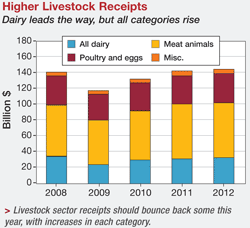Let the Door Slam on 2009

Good riddance to 2009. That's what livestock producers are shouting from the rooftops as the books close on a difficult year for hog, dairy and beef producers.
"There were just too many major demand and cost shocks in the past two years for an industry that has become too inflexible to downsize,” says Chris Hurt, Purdue University livestock economist, of the hog industry. A slumping world economy, a downturn in export markets and the effects of HINI all helped to erase hog profit margins.
Lenders to pork producers are increasingly facing bankruptcies for their poorest-performing loans. Hurt calls the recent downward adjustment in the hog industry a forced one, revealing just the "tip of the iceberg” of the lost equity across the sector. He believes the industry must now drop another 3% to 5% of the breeding herd to get small enough to return to break-even.
Cattle Market Mess. Lower demand for beef products, heavier cattle and ever-increasing dairy cow slaughter pushed beef prices further down throughout most of 2009. Lower milk production and an increase in dairy product exports, however, is expected to improve dairy and milk prices in 2010, according to the USDA–Economic Research Service.
While weekly cow slaughter remained above five-year-average levels in 2009 for the most part, it exceeded 2008 levels only intermittently after staying above 2008 levels for most of the first quarter, says Kathryn Quanbeck, USDA ag economist.
Except for early in 2009, beef cow slaughter remained below 2008 levels and only recently again exceeded 2008 levels. On the other hand, dairy cow slaughter exceeded both 2008 and five-year levels for most of 2009, falling below only during some weeks in spring and early fall. These levels of dairy cow slaughter can be attributed to low milk prices and several rounds of Cooperatives Working Together program whole-herd buyouts.
Livestock Receipts Rebound
Stewart Ramsey, senior economist in IHS Global Insight's agriculture division, says many livestock producers could see a return to profitability in 2010 as rebounding exports and domestic demand lead prices higher.
He forecasts higher steer prices the next three years, with hogs and poultry leveling off in 2012 (see graph below).
Livestock sector receipts will rebound to more than $130 billion this year, with increases in each category. By 2011, they will be back to 2008 levels, exceeding $140 billion (see graph below). 
Top Producer, January 2010







